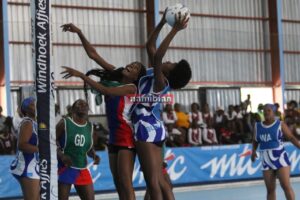[ad_1]
THE Confederation of Namibian Fishing Associations (CNFA) has distanced itself from the horse mackerel sector’s fight to be allowed to fish in a seabed area which has been protected for the past 25 years.
The sector wants to do this in order to save land-based factories from closing.
Earlier this week, the confederation’s Matti Amukwa declined to accept a petition signed by of over 300 employees of the horse mackerel wet landed sector at Walvis Bay.
The workers are demanding that their employers be allowed to fish within the 200-metre isobath area, which serves as a breeding ground for fish and the development of juvenile fish stocks in the ocean.
The employees are mainly from Gendev Fishing and Princess Processing Brand.
The two companies, with a combined workforce of 1 400, face closure due to low catches, which they blame on climate change as the fish resources migrate into the 200-metre isobath area where the water is warmer.
Amukwa refused to receive the petition due to the fact that the companies belong to the Wet-Landed Horse Mackerel Association, which is not a member of the confederation.
He told the petitioners that they delivered the document to the wrong address.
“Even if I accept your petition, I am not going to do anything about your petition because they (the companies) are not members of the confederation. The confederation’s position remains. It never changed and it is what it is. For the confederation to attempt to give attention to your petition, let those you are representing become members of the confederation. We cannot attend to unknown members,” said Amukwa.
He told the group that the confederation attends to issues of the industry and not individual companies.
The confederation consists of the Monk Association, Horse Mackerel Freezer, and Hake Association.
The chairperson of these associations are Peya Hitula, Peter Carlson, Amukwa, and Gerrie Hough as the secretary.
The four all have a stake in the Swapo-linked company Tunacor.
Tunacor, which also catches wet landed horse mackerel, is not part of the Wet-Landed Horse Mackerel Association.
The confederation is the only fisheries group that sits around the table with the fisheries minister.
Last week, the Wet-Landed Horse Mackerel Association also distanced itself from the CNFA, after Amukwa made similar remarks related to membership during an annual industry engagement with the minister of fisheries and marine resources.
In a statement, the sector questioned why the CNFA refused to hear them out.
“Instead of hearing our plight and the actual facts and science, the CNFA opted to question our CNFA membership, as well as refer to us publicly as ‘two companies’ rather than an association. As a result, we reserve our rights of whether or not to continue under this umbrella.”
In the petition, read by Silas Petrus, the employees of the wet horse mackerel companies asked the confederation to intervene in their request to Cabinet to have the sector (wet and freezer) be allowed to fish up 70 metres into the 200-metre isobath zone.
Currently, it is only Namibia that has this rule within the Benguela Current Convention.
South Africa has 150m depth restrictions and Angola has none.
The employees asked that Amukwa set aside business rivalry and consider the employees social status.
“As a leader of the confederation, what solutions and suggestions do you have for us who are suffering and continue to suffer while other companies are benefiting from these resources?” said Petrus.
According to a scientific study conducted between 3 and 28 March this year, titled the ‘Cruise Report – Horse Mackerel and Small Pelagic Survey of the Northern Benguela’, most adult horse mackerel resources (17 cm) were predominantly found at depths of approximately 111,72 to 249,43 metres, with an average bottom depth of 183,71 metres.
The juveniles were predominantly observed in bottom depths of between 15 and 147,82 metres, with the average bottom depth of 73,57 metres.
[ad_2]
Source link




